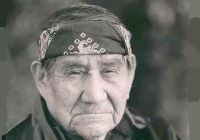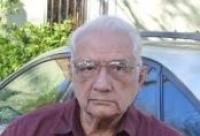Navajo man in turquoise shirt and blue pants riding an orange Harley Davidson motorcycle. This wood carving is by Delbert Buck, and measures 11.5” long and 7.5” high.
Delbert Buck, born in 1976, has been showing his folk art in galleries since he was 14. He is an electrician and makes his carvings in his spare time. His whimsical figures usually depict Navajo life on the reservation. Other figures are from his imagination, and display satire and humor.
About the artist
Delbert Buck
Delbert Buck got a young start as a folk artist. Like other Navajo folk artists, Delbert is self-taught with the unusual distinction of starting at the ripe old age of nine. His artwork started in an innocent way - with the carving of toy guns for his younger brothers. The idea of carving figures just came to him. He first thought of carving a horse as he is an avid horse lover and rodeo participant, his favorite being bull-riding. The horse was soon followed by a chicken and then a goose. He didn’t think about adding a human being to his pieces until his fifth carving. He thought it would be funny to show his grandma driving a truck. He had only seen her drive once and thought it would be a funny image…..he never did show his grandmother that piece but he managed to get a laugh out his mother.
He began making sculpture from found objects at age twelve and was represented in a gallery by the time he was fourteen. It was in 1988 that Delbert’s father Wilford Buck introduced his son to trader Jack Beasley, of the Four Corners area. With his father handling the boy’s art business, Delbert says he didn’t even know the value of money until he was in in his teens.
He assembles constructions from found objects and cottonwood limbs, then roughly carves and paints them. All of his carving is by hand. His tools are simple: a hammer, a handsaw and a utility knife. He uses acrylic paint and a wide variety of found materials. Paper, fabric, yarn, and wool all find their way into his work. He even sews the clothing on his figures, as taught by his mother. After some experience packing his own work and realizing the fragility of the sculptures, he has begun to experiment with a flexible rubberized material for feathers, instead of the more breakable wood.
His inspirations are many. His ideas come from looking around at the ordinary things in his daily life whether animals or people. The greatest encouragement of his work has come from his parents, especially his Mom. He listens to stories told by his mother and grandmother. His Mom also gives him ideas. He feels his work has a life energy all its own. He can look at one of his carvings and envision a man riding a chicken down the road. Some his favorite and repeated topics are airplanes, horses and cowboys, and wagons. He doesn’t study the work of other artists because he feels his work has its own particular character. However, he is inspired by the work of Charles Willeto (Navajo 1897-1964 medicine man who became a folk artist late in life) knowing there is a place in the world of art for his unique interpretations.
First there were the comic books that encouraged him to think it possible for a sheep to drive a car. As he aged, he drew on personal experiences, such as his rodeo bull riding, the colorful chaps he wore in rodeos, and his trips in a single engine airplane, to inspire his sculpture.
Delbert’s art is humorous and even satiric. His cowgirls and cowboys ride be-speckled skunks, buffaloes, propeller planes, rocking horses, or giraffes, with a goat in chaps and hat, or maybe a monkey or dog, riding behind. A wagon filled with pigs, Dalmatians, or chickens is pulled by a booted pig or an oxen-sized dog. It might take Delbert three to four weeks to complete one of his larger pieces.
Delbert, born in 1976, is one of eight children. He lives in the Farmington area. Besides his artistic career, Delbert has studied and worked as a physical therapist, an auto mechanic, and, most recently, he is pursuing electrical studies for his journeyman’s license.
His favorite part of the artistic endeavor, and the main thing he hopes others will find in it, is the smile it gives when it’s all finished and comes together in a funny, improbable sculpture. This desire to make people feel better spans all aspects of his life.
"I'm just an ordinary guy. I'm surprised how people have responded and that I can make a living from my carving."













